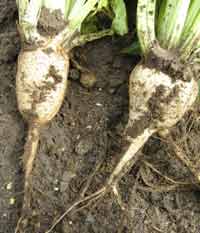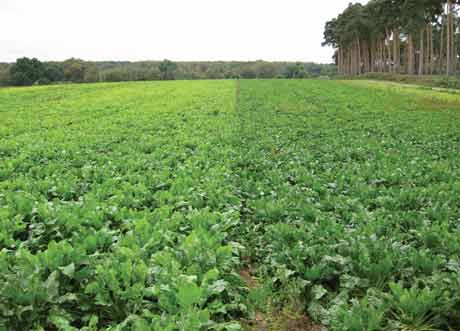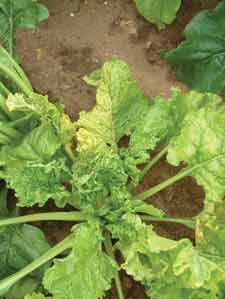Rhizomania resistance-busting sugar beet virus detected

A new strain of the rhizomania virus has been implicated in overcoming previously resistant varieties’ defence in a small number of sugar beet crops.
“All current rhizomania-resistant varieties are only partly resistant to the virus,” says Broom’s Barn researcher Mark Stevens. “That means it can infect the plant, but doesn’t build up to the same extent as in susceptible varieties. Nor do infected plants show any symptoms.”
But in three fields in 2007 and five in 2008 patches of rhizomania symptoms have been noticed in resistant varieties in East Anglia.
Analysis by Broom’s Barn has identified a new, unique strain of rhizomania in all those fields, Dr Stevens says.
Previously, three main types of the virus that causes the disease – officially beet necrotic yellow vein virus – had been identified, he notes. In the UK the most common, A and B, are hard to distinguish outside a laboratory and cause similar yield losses.
The more virulent, and potentially more aggressive, P-type has been found occasionally, first in Norfolk in 2001 and again in 2007. It would pose a serious threat to the industry should it became established here, Dr Stevens warns.
But Broom’s Barn’s molecular analysis found no evidence of the P-type last season.

Rhizomania-resistant varieties showed varying levels of symptoms where the new strain was found
The 64 positive samples from the 2008 rhizomania survey have been typed further using molecular markers. Two strains of the A and B types predominated. A third, found at one site in north Norfolk, is common in other sugar beet growing regions of Europe.
But the fourth found in all the fields of rhizomania-resistant varieties that showed symptoms had a unique genetic make-up, he says. “Our tests confirm it is not the P-type and, so far, it has not been identified anywhere else in the world.”
Further analysis of the samples from the three fields from 2007 showed the same unique amino acid sequence in the virus’s genetic make-up.
“It’s not yet clear whether this strain explains the development of symptoms in these rhizomania-resistant varieties, and more work is in progress to investigate the significance of all these strains in the UK.
“There does seem to be some varietal difference in susceptibility to this new strain. By chance, there were three resistant varieties in one of the badly affected fields surveyed (main picture).
“At another site, where only one resistant variety was grown, the roots in the infected patch were 50% lighter and had a sugar content of 16.3% against 17.5% where no disease was present.
“We presume that minor genes within the varieties’ genetic background may cause differences in resistance. Some may be helping to strengthen the effect of the resistance gene and so causing variation in responses to the unique strain.”
Elsewhere in the world, notably the US, France and Spain, rhizomania in resistant varieties had been put down to high inoculum in the soil and/or favourable weather allowing the virus to overcome the single defensive gene, known as Holly or Rz1.
“But our and other recent work shows these soils tend not to have exceptionally high levels of the disease and that the breakdown could be due to potentially ‘resistance-breaking’ strains.”
2008 survey findings
|
|
During summer and autumn, crops in all four factory areas showed rhizomania symptoms mainly, as expected, in susceptible varieties.
The symptoms ranged from single or small clusters of plants showing pale green discoloration of the leaves to large patches covering many square metres or even whole headlands.
No “yellow vein” symptoms, caused when the virus is carried passively from root to leaf (above left), were recorded last season. “These are rare under UK conditions, but common on the Continent,” says Dr Stevens.
In many cases the classic “root bearding” showed, often with “rats tails” leading from the tap (above right) whose internal tissues were discoloured brown.
Rhizomania history Rhizomania is a serious threat to sugar production in all factory areas. To combat it and limit its spread, 32% of the 2008 UK crop area was sown with resistant varieties in 2008 and the figure for this spring is expected to be at least 42%.
Recent warm, wet springs and early summers have helped the disease build up and spread, and once present it cannot be eradicated.
- For more from Beet 09 click here



